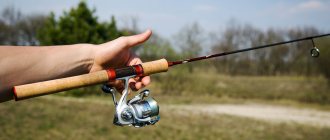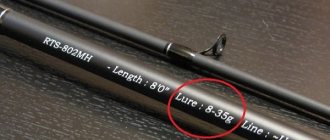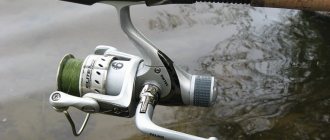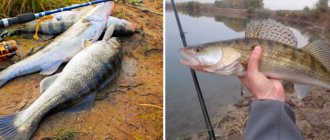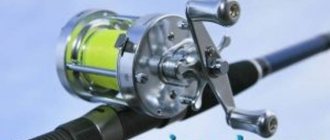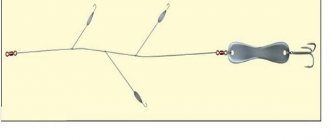The easiest way to catch predatory fish is to arm yourself with a spinning rod and go to the body of water where these fish are found.
If you have at least some experience with spinning rods, then this is not a problem. If you pick up a spinning rod for the first time, then the first thing you need to master is the casting technique. Spinning is a tackle that has its own characteristics, depending on which reel is installed on the fishing rod. Basically, they resort to installing an inertia-free reel, which is easy to operate and has acceptable functionality. Whatever the reel is installed, you still need to master the casting technique. In addition, you will have to train for accuracy and casting distance, since the effectiveness of the entire fishing depends on this. This article is intended for those spinners who have picked up a spinning rod for the first time in their lives and are thinking about how to use it correctly and effectively. Any theoretical knowledge must be supported by practical skills. Theory and practice are the power that allows you to always have a positive result. Having mastered the basics, which are outlined in theory, it is easy to master the practice of using spinning tackle.
Techniques and methods of casting spinning rods
A spinning cast consists of several parts:
- swing;
- throw;
- bait management process;
- sinking to the bottom.
Casting with a spinning reel
Spinning with a spinning reel is the most common, so fishermen have come up with several casting methods.
1. Circular overhead cast
If an angler has managed to master this method, he ceases to be a beginner, since he will be able to throw the bait exactly at the target. Casting does not require a lot of free space. You need to find a gap between the tree branches and settle there.
2. Pendulum cast
The simplest cast according to fishing technique. It is used if there is a limitation in space. You can perform a pendulum cast from the shore or while in a boat; the line is cast along a low trajectory. Casting range no more than 15 m. Performed as follows:
- Make the hanging line shorter - less than 70 cm.
- Swing the rod backwards.
- From the 10 o'clock position we sharply move to 12 or 1:30.
- We swing the load slightly and throw it.
- Lower the rod tip evenly downwards.
- We tighten the line.
- Let's enjoy fishing!
This technique is the most convenient and easy to learn. If the rod is turned to the right or left, the pendulum cast will turn into a side cast.
3. Side cast
It is performed exclusively from the shore; there is no need to perform such manipulations from a boat.
- The line should hang down less than 50 cm.
- Place the rod parallel to the ground so that the bait does not reach the surface by 15-25 cm.
- The main emphasis is not on the arms, but on the torso.
- Move it with one hand to the right or left.
- Move smoothly forward while lifting up.
4. Catapult casting
This type of casting is used extremely rarely, since the accuracy of hitting the right place decreases, although the distance, on the contrary, is longer than with other types.
- Carefully release the line from the reel spool.
- Pull the hook of the bait towards you, bending the rod.
- Release in the desired direction.
Catapult casting can be used when there is an acute shortage of free space.
Casting with a multiplier reel
The mistake of a novice fisherman is to cast a spinning rod with a multiplier reel the same way as with a spinning reel. This requires smoothness and no sudden movements.
A few tips to help you master the technique of casting with a baitcasting reel:
- Hold the rod horizontally.
- Adjust the hang of the sinker - 20-30 cm from the tulip.
- Press the bobbin release button.
- Press the line lightly with your finger and let the sinker fall to the ground.
- Choose a suitable place so that there is enough space at the back to swing.
- You should grab the rod with your right hand.
- Touch the key with your thumb.
- With your left hand, grab the bottom of the handle.
- Lift the rod up and back 45 degrees.
- Press the bobbin release button.
- Smoothly swing forward and launch the line.
- After the load falls, turn on the fishing line rewind.
It won’t all work out right away, but a few dozen casts will allow you to adapt and master the main skills.
Long-distance spinning casting technique
Over time, the fisherman will have to master the technique of long casting. The general recipe is to wind more line on the spool, take a long rod, attach a heavier load. However, under other circumstances, you can throw the bait quite far.
It is necessary to take into account the structure of the spinning rod. The casting distance is affected by the rod length and action.
It is better to choose a device with a slow action, but as practice shows, only a few do this. Basically, few people pay attention to the diameter of the fishing line itself, but in vain! A slight difference in the cord of 0.15 and 0.20 mm gives a noticeable difference in meters. With a thinner line you can increase the throw by 5-8 meters. It is also necessary to take into account the structure and weight of the bait.
No matter how well the throwing technique is developed, without a spinning rod with the appropriate parameters, you will not be able to make a long throw.
With two hands
A more powerful cast, which is performed approximately according to the same scheme. This method requires more strength. To perform it correctly, you will need a two-handed rod.
How to do it:
- We put on a big bait.
- We put our feet in a supporting position.
- We take the rod with both hands.
- Cast vertically so that the tip of the rod is behind your shoulder.
- Bring the top to the ground.
- Cast sharply forward.
- When winding the fishing line, help with your index finger and thumb.
What does range and accuracy depend on:
- Hand placement.
- Timely reeling of fishing line.
- Lure weight.
Main mistakes:
- Incorrect hand placement.
- A large amount of fishing line.
- Little bait.
How to cast a spinning rod correctly
Nowadays, equipping a fishing rod with a spinning reel is a classic option for spinning fishing. Therefore, we will understand the throwing technique more thoroughly by working through the algorithm of the fisherman’s actions. Holding the line on the tackle form with your finger, while lowering the bait thirty centimeters from the tip of the rod, open the line handle
When retracting the spinning rod to the starting point of the swing, the swing point in relation to the angler will be located based on the angler’s choice of the type of casting required at the moment, you should pay attention to the tip of the rod and the hanging line with the bait
The cord should be in the last ring of the whip, but in no way on the blank. Then a swing is made with a synchronized release of the fishing line when the bait comes in line with the rod blank. In practice, the flight of the bait and the position of the blank, when stopping after the swing, are a directed vector. When the bait is in the water, the line holder is closed. It is advisable to close it manually, and not by turning the reel handle, so the reel will last much longer without being subjected to unnecessary and unjustified loads.
After closing the line holder, the casting is considered completed and you can begin retrieving. Carrying out the sequence of these manipulations fully solves the question of how to properly cast a spinning rod with a spinning reel.
Tips for beginners
At the end of this post, let me give you some advice:
- Train in optimal conditions. You won’t be able to fish accurately right away, because the fish usually stands in hard-to-reach places where there is a high risk of getting caught. Go to a large body of water with minimal wind, throw the bait at a selected point in the free water. At the same time you will work out the wiring.
- Use other people's experience. No descriptions, photos or videos can replace real mentoring. It is ideal if during your first trips you will be accompanied by an experienced technician who will help you install the equipment and prevent critical mistakes.
- Don't go beyond the rod's specifications. At first, select equipment elements exclusively within the framework of the form test. Later, when you become a pro, you will be able to throw heavier baits with ultralights. And at first do not take forms longer than 2.1-2.4 meters, even when fishing from the shore.
Good luck to you, beginning spinners! Fewer annoying snags, more enviable trophies and incredibly adrenaline-pumping experiences!
How to cast correctly?
At the moment, most often, fishermen prefer to use inertia-free reels, which actively outperform classic inertial reels.
Based on this, it is worth paying attention to the technique of casting a spinning rod equipped with more modern devices. Regardless of whether a feeder, ultralight or casting rod is used, the algorithm of actions will be the same with some nuances determined by fishing conditions and other factors
The sequence of actions is as follows.
The bait is hung 20-30 cm from the last winding ring. The fishing line fiber is pressed against the blank with your finger. The reel bow opens. The spinning rod is retracted to the starting point, which depends on the chosen type of casting. The position of the fishing line (cord), bait and rod tip is checked
It is important to make sure that the line fiber is on the ring and in no case on the whip. A swing is performed. When the nozzle and blank come out on the same line, the line is released. The line handle closes as soon as the bait reaches the water. In order to minimize the load on the coil, it is recommended to carry out this operation manually, rather than by turning the “meat grinder” handle. The bait is retrieved taking into account the characteristics of the chosen fishing method and the corresponding equipment.
Both beginners and more experienced spinning fans are interested in the secret of casting as far as possible. First of all, it should be noted that we are talking about a combination of such important factors as the characteristics of the gear and the choice of specific equipment. Vertical casting allows you to send the bait to the maximum distance. However, in tandem with a long rod this will lead to improved results. As practice shows, the farthest sending of bait is ensured by the use of spinning rods with a length of 3 meters, having a semi-fast or fast action.
It is important to take into account that the desired results can only be achieved with appropriate effort. Also, the determining factor will be the availability of sufficient free space for a full swing.
In the context of fishing conditions, the presence of obstacles (most often in the form of vegetation on the shore) and a strong side or head wind are taken into account.
An equally popular and discussed topic concerns the accuracy of sending baits. In this case, only frequent training in different conditions will help achieve outstanding results. With appropriate practical skills and experience, each of the casting methods described above can provide the required accuracy. By the way, fishermen often hone their skills not only on reservoirs, but also on land.
In practice, accurately delivering the bait to the desired point looks like this:
- the fisherman marks a specific area on the water;
- The casting of the tackle is carried out directly, taking into account the fishing conditions and the characteristics of the equipment used, as well as with a certain effort;
- During the flight of the nozzle, the speed and trajectory of movement are adjusted by applying pressure to the fishing line fiber with your finger.
The use of inertial spinning reels deserves special attention. In such situations, the key point is the ability to timely and effectively change the speed of the nozzle. Otherwise, there are no significant differences from inertia-free devices in casting techniques.
It is worth noting that the inertia makes it easier to throw horizontally (sideways). This is due to the fact that less force is applied to the coil. At the same time, when using the classical technique, the feeding force will be much greater, which can lead to the formation of a “beard”.
Parameters of long-range spinning rods
The ability to make long casts requires a harmonious combination of all components of spinning tackle. This includes an appropriate reel, a suitable fishing line, and a bait that meets the test characteristics of the blank. But, of course, the most important link is the spinning rod itself. It is its parameters that primarily determine the possibility of long-distance casting. When choosing a long-range fishing rod, the following characteristics are primarily important:
- Length.
- Build.
- Passing rings.
The technique of casting the bait is also very important. If casting is performed incorrectly, even the longest-range spinning rod will not be able to provide the required range.
Length
The possible casting distance directly depends on the length of the blank. This parameter is considered the main one for a spinning rod that is planned to be used for long casts. Short blanks should not be considered for this purpose, as they will not be able to provide a decent swing and the necessary inertial force.
The length of the spinning rod for long-distance casting should start from 2.7 meters. Such a stick, with proper experience of the fisherman, will help to cast the bait at a distance of 80 - 100 meters. This is quite enough when fishing on lakes, medium rivers and bays.
Expert opinion Knipovich Nikolai Mikhailovich Zoologist, hydrobiologist. I am interested in fishing at a professional level.
Interesting! Spinning rods designed for long-distance casting most often have a plug-in design and consist of three legs.
A rod length of 2.7 to 3.2 meters is considered optimal for making longer casts. Such spinning rods can be used on large rivers, lakes and reservoirs.
There is no need to take longer sticks, as they have quite a serious weight and will be uncomfortable during active fishing. It is advisable to take them only for sea fishing. In such conditions, it is possible to use rods up to 4.2 meters long.
Build
The rod's structure is very important for long-range spinning. As is known, whips, depending on the characteristics of their structure, are divided into three main categories:
- Fast action rods bend under load in the upper part.
- The rods are of medium action (bend in the upper half).
- Slow action rods (bend along the entire length).
Spinning rods with a slow action are considered the most suitable for long-distance casting. Due to the bending of their entire body, they create sufficient inertia and throw out the bait themselves, like a good spring. But their disadvantage is that they are not sensitive enough, and it is difficult to make a quick, timely hook with them. All work with such whips is carried out with a large amplitude, which is not always convenient.
Medium action spinning rods also allow you to make long throws, but without the angler having some experience, this will be somewhat more difficult to do. But they are quite sensitive and allow you to make fairly quick hooks.
To cast long distances with a fast action rod, the angler must confidently master a certain technique. A beginner will not be able to cast bait far with such a spinning rod; they are rigid and will not be able to provide sufficient inertial force. But the advantage of these whips is their sensitivity and the ability to make an instant hook. Therefore, such spinning rods are the choice of professionals.
Passing rings
The size, quantity, location and quality of the spinning rings also has a serious impact on the possible flight range of the bait. Their main function when casting is to guide the cord (line) from the reel to the tulip and hold it.
In this case, the friction force of the fishing line on the inner surface of the rings plays a serious role in the casting process. At first glance, this factor may seem insignificant, but given the speed of movement of the cord and the fact that there can be up to 7 - 9 units of guide rings, it becomes clear that the resistance to the movement of the bait created due to the friction force can be significant and long-distance casting with a spinning rod will be complicated
It is also very important to ensure the precise alignment of the rings. They must be strictly on the same line
The basic requirements for the guide rings of such fishing rods are:
- Significant diameter, especially at the initial rings located closer to the coil.
- Internal inserts made of hard and smooth material, such as carbon or titanium.
- High quality fastening. They must be integral with the body of the form.
The number of rings is also an important parameter. There should be no more of them than is required to evenly distribute the load on the rod when playing fish.
Common mistakes
We have already mentioned most of the typical mistakes; all that remains is to systematize them:
- Manipulations with the line laying machine. In the initial phase, the line guide must be open. This must be brought to automaticity, otherwise during power casts you can part with the bait due to a broken line, and in the worst case, break the spinning rod. After splashing down the bait, it is better to manually close the bow, without waiting for automatic operation when winding - this will make the reel last longer.
- Rod control. The fisherman must clearly understand what this or that manipulation will lead to. In the final phase, the rod should be positioned horizontally, at a slight angle to the direction of the line (depending on the current and wind conditions). No need to lift it up or try to position it exactly “on line”!
- Hooking the equipment onto the “tulip”. When fishing for pike, a mandatory element of the equipment is a leash (metal, Kevlar, fluorocarbon twist, and so on). In its absence, the predator will instantly bite the fishing line. Sometimes, in the heat of the moment or due to inexperience, the leash is wound close to the last ring of the spinning rod or even passed through it. The result is a line break, premature wear of the ring and other “delights”.
- Hand position. Remember that the leg of the reel seat should be located between the index and middle fingers of the working hand. The fishing line is fixed (slightly pressed) with the index finger. It must straighten clearly at the moment of the “shot”, otherwise the bait will go up, will not fly far forward, and the fishing line will most likely get tangled. Let go late - the distance will be reduced, and you can damage your finger.
- Casting technique. The spinning rod is thrown in one movement, without fixing at the end points of the trajectory: we pull it back and immediately send it forward. There is no need to freeze in an extreme position: the message should be a single whole.
Types of casting
To cast with spinning tackle, there are four fundamental methods, on the basis of which you can experiment with their variations in improving and rationalizing the delivery of bait under certain fishing conditions. These four pillars are:
- vertical cast;
- horizontal cast;
- pendulum cast;
- throw like a catapult.
All of the above types make it possible to throw equipment under any conditions. Let's take a closer look at each method in which you can cast a spinning rod.
Classic casting
Vertical or classic casting of tackle is the most famous and widespread method of presenting bait among spinning fishing enthusiasts. Carried out in an environment that does not impose requirements on its closeness
The fisherman has complete freedom to swing, and there are no obstacles in the form of trees, bushes or, which is especially important to pay attention to, power lines near the fisherman’s location. The bait is thrown by the angler with the spinning rod raised vertically up behind his back. Then a sharp swing is made and the bait is delivered
This method is characterized by long range and considerable accuracy.
Then a sharp swing is made and the bait is delivered. This method is characterized by long range and considerable accuracy.
Side throw
A horizontal or side cast is used in cases of obstacles in the fishing area that do not allow the rod to be positioned vertically. Tree branches hanging over the water are the most common problem, which gives reason to use just such a technique when it is necessary to cast a spinning rod. The fisherman performs these actions in complete similarity to the technique of the previous cast, only the rod is held in a horizontal position and retracted from the side. Before throwing the bait, the angler decides on the casting side, moves the rod to the side and throws a spinner or other bait at the fishing point. The main skill development for executing a throw with this technique is to timely withdraw the finger holding the line on the blank. When performing horizontally, you have to react to removing your finger much faster, and when changing the method from vertical, it is especially difficult to adjust to removing your finger not in a straight line, but from the side. A quick response to the release of the line significantly affects the accuracy and casting distance of the spinning rod.
Pendulum throw
The pendulum throw allows you to throw the bait close, but very accurately to the intended point. It is used mainly for fishing in open windows among aquatic vegetation or spaces among visible areas of snags in the water area. Casting is facilitated by the constraint of performing the above-described techniques. Often such a cast has to be performed on a river bank, completely covered with a wall of vegetation that is several times longer than the length of the rod blank. The bait is released from the tip of the rod ten centimeters. Holding the freed line, the bait is swung parallel to the form and, when swayed towards the reservoir, it is released, placing it in the required place. The technique is complex and requires a certain amount of time to complete it.
Ejection
Ejection is the most complex technique. This type is used when it is completely impossible to implement the three previous ones. The peculiarities of the throw are short distances and relatively low accuracy, but if the place is particularly promising, then you need to try, especially since there is an option for serving. With this method, the angler takes the bait in his hand, pulling the thread of the tackle until the tip of the rod bends and, when he feels the elasticity of the whip, shoots the bait, simultaneously releasing the line from the blank in unison with the bait. The complexity of the technique lies in the fact that the angler has to keep the spinning rod in a tense state when casting, while simultaneously controlling the bait and the clamped fishing line.
How to accurately send bait to one place
High casting accuracy can only be achieved through long practice. A novice fisherman needs to be prepared for the fact that at the initial stage the bait will not fly where he planned. There are several rules that can help in mastering an accurate throw:
you should not make a large overhang of the bait; you need to focus your attention on accuracy, and not on the throw range; The weight of a spoon, wobbler or jig head should always be within the test limits of the rod.
At the initial stage of mastering spinning gear, it is recommended to choose a landmark on the opposite bank and cast at it. The range can be controlled by slowing down the line coming off the spool with your hand.
Types of casting
Correct casting of a spinning rod is a fundamental factor for successful fishing. Beginning fishermen do not always know how to cast a spinning rod in order to hit the desired point and send the bait to the maximum distance.
First of all, you need to pay attention to the correct balancing of the tackle, and only after that choose the right type of casting tackle. The choice of casting type depends on the fishing conditions and your skills, as well as on the characteristics of the gear used
Side cast
This method is most often used to cast a spinning rod from the shore. Great for fishing in strong winds and in difficult conditions. When the banks of a reservoir are densely overgrown with reeds or aquatic vegetation, you can only deliver bait into the water using a side cast.
When using such a cast, it is important to pay attention to the fact that the bait hangs from the tip of the spinning rod by about 30 centimeters. Now you need to move the rod back and in the opposite direction, as shown in the diagram above. When casting, the line must be released at the moment when the rod passes the top point
When casting, the line must be released at the moment when the rod passes the top point.
If you notice that the bait has fallen exactly opposite you, then the cast can be considered successful with full confidence. This is one of the easiest ways to cast a spinning rod, which is often used by novice fishermen, but the accuracy suffers a little.
Over the head
This method of casting allows you to deliver the bait into the water with great accuracy; only to implement it you will need to equip the rod with a spinning reel. The inertial reel significantly reduces the accuracy of casting over the head.
This is how most fishermen cast their spinning rods, including me. It is great for fishing from a boat and from the shore, even if there are bushes nearby. True, beginners often make mistakes when throwing over their heads - they either lower the spinning rod too much behind their back, or apply too much physical force.
Accordingly, if you make a mistake, you will significantly reduce the casting accuracy
It is important that the bait describes an elongated circle while casting. When it passes the extreme point behind the fisherman’s back, the line must be released so that the bait does not stop, but continues its movement, picking up speed.
From under the hand
This type of casting does not have a particularly long range, but it can be used in any conditions. But in this way you can throw bait in any conditions. Most often, casting is used when fishing from a boat with two people or when fishing from the shore in dense thickets.
You can cast a spinning rod in this way using any reel, which makes it virtually universal, since both closed-type and inertia-free reels are suitable. All you need to do is stretch the spinning rod out in front of you in a horizontal position, then tilt its tip down a little and make a sharp rise up.
All that remains for the fisherman is to wait until the tip of the rod takes a horizontal position and release the line. Immediately after this, your bait will go to the fishing spot. The main thing is not to miss the right moment and release the line on time.
Over shoulder
This type of casting allows you to effortlessly cast bait in places where there is very narrow free space. You need to take the spinning rod in such a way that one hand is on the handle, and the other is slightly above the reel. Now tilt the spinning rod back so that the reel is at the level of your shoulder.
Now you need to tilt the spinning rod so that its tip almost reaches the ground and make a sharp jerk, just don’t overdo it. As soon as the spinning rod is at the level of your head, you need to release the line.
When you notice that the bait will soon fall into the water, you need to point the tip of the rod approximately at the point where the bait will fall, and then observe. As soon as the bait is in the water, you need to close the bow and reel.
With two hands
This casting method allows you to make the most powerful and long-distance casts, and doing it is no more difficult than previous methods. But to use it, you will need to use a spinning rod with two handles and apply much more force (with long-term fishing, your muscles will get tired faster).
Over shoulder
If there is no room to turn around, then the over-the-shoulder method is suitable. Suitable for narrow fishing spots.
How to do it:
- We put on bait.
- Take a supporting position with your feet.
- Hold the rod with both hands (near the handle and reel).
- Cast vertically so that the tip of the rod is behind your shoulder.
- Bring the top to the ground.
- Cast sharply forward.
- Release the holding finger when the rod is above your head.
- After finishing the line, tilt the top towards the bait.
What does range and accuracy depend on:
- Hand placement.
- Swing no further than your head.
- Correct casting technique.
Main mistakes:
- Swing forward beyond your head.
- Incorrect hand placement.
In order to correctly perform this method, just look at the picture above.


